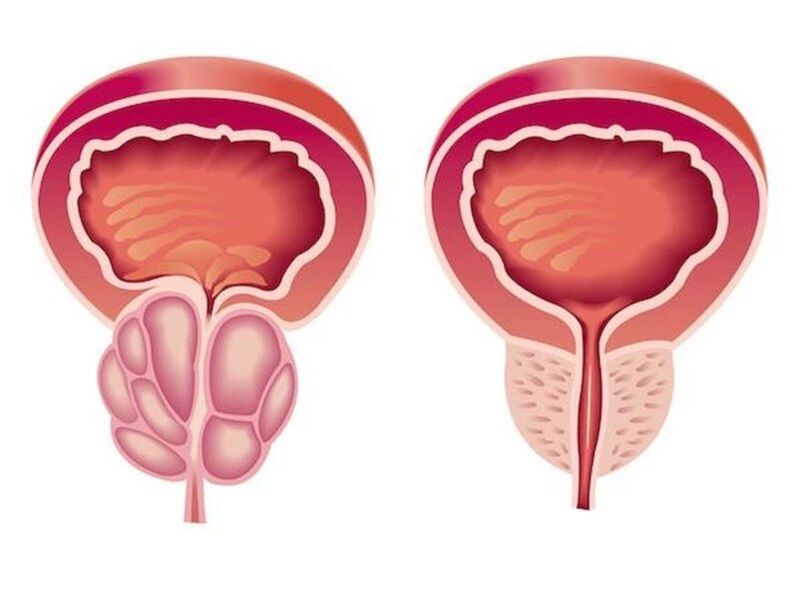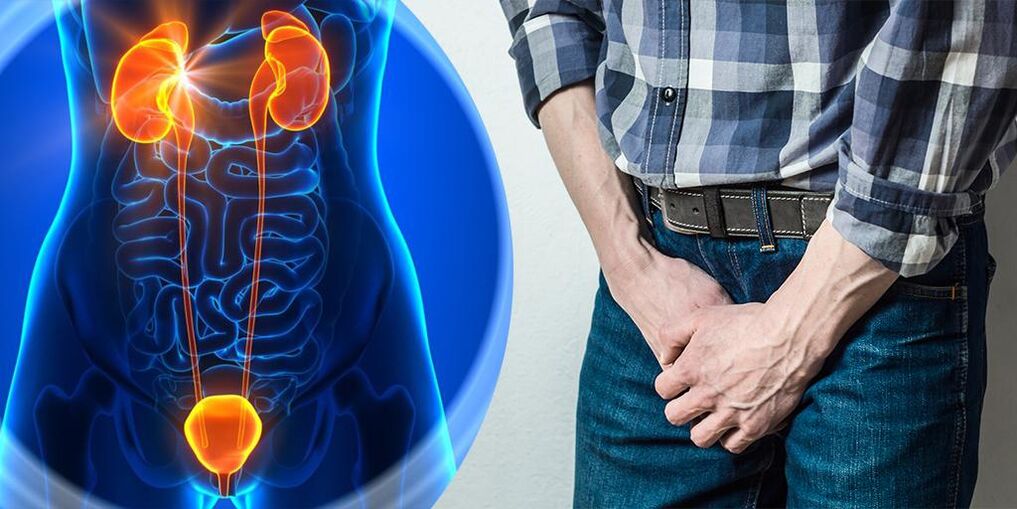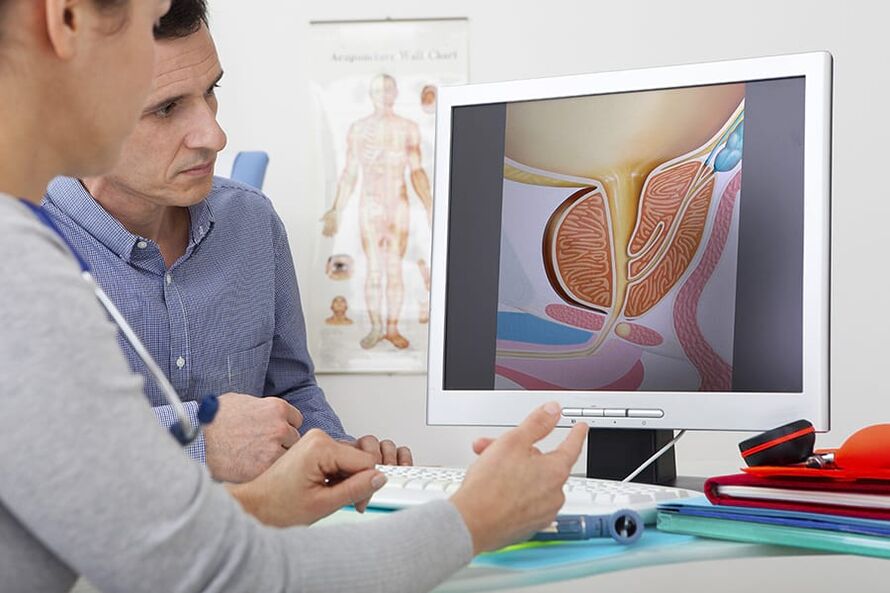Prostatitis is an inflammatory disease of prostate glands. It is manifested by frequent toilet campaigns, penis, scrotum, rectum, sexual disorders (erection, early ejaculation, etc. ), sometimes deferred urine and blood insurance. The diagnosis of prostatitis established a urologist or other specialist in a typical clinical picture, results of a rectal study. In addition, ultrasound prostate is carried out, the sowing bacteria of prostatic secretion and urine. Conservative treatment - antibacterial therapy, immunotherapy, prostate massage, lifestyle correction.

General information
Prostatitis - inflammation of seeds (prostate) glands - prostate. It is the most common disease of the genitourinary system in men. Most often affects patients aged 25-50 years. In accordance with different data, prostatitis suffers from 30-85% of men older than 30 years. Perhaps abscense a prostate of prostate, testicles inflammation and additions, which threatens infertility. The rise of the infection leads to inflammation of the upper parts of the genitourin system (cystitis, pilonefritis).
Pathology is developing when an infectious agent is entered, which enters the prostate fabric from the genitourinary system (urethra, bladder) or from a distant inflammatory focus (with inflammatory, flu, tonsilitis, furunculosis).
Causes of prostatitis
GOLD STAFILOKOK AUREUS (ENTEROCOCCUS), Entereobter), Pseudomonas (Pseudomonas), Proteus (Proteus), and Klebcelllah and Klebcelllah can act as an industrial agent in an acute process. (Klebsiella) and E. Coli (E. coli). Most microorganisms belong to the conditionally pathogenic flora and causes prostatitis only if there are other predisposing factors. Chronic inflammation usually causes Paul with microbial associations.
The risk of disease development increases during hypothermia, presence of specific infections and conditions in the history of congestion in prostate tissues. The following predisposition factors differ:
- General hypothermia (single or permanent, related to working conditions).
- The sedentary lifestyle, a specialty forcing a person to be in a sitting position for a long time (computer operator, driver, etc. ).
- Constant prison.
- Breaches of the normal rhythm of sexual activity (excessive sexual activity, extended abstinence, incomplete ejaculation during deprived emotional colors of "common" sexual relations).
- The presence of chronic diseases (cholecystitis, bronchitis) or chronic infectious foci in the body (chronic osteomyelitis, absurd caries, tonsilitis, etc. ).
- Urological diseases transferred (uritis, cystitis, etc. ) and sexually transmitted diseases (trichomonia, gonorrhea).
- States causing the inhibition of the immune system (chronic stresses, irregular and inferior nutrition, regular lack of sleep, the state of searching in athletes).
It is assumed that the risk of pathology development increases to chronic consumption (alcohol, nicotine, morphine). Some studies in the field of modern andrology prove that a challenging factor is chronic injury to mutual termination (vibration, concussion) in motorcycles, motorcyclists and cyclists. However, a huge number of experts believe that all these circumstances are not the real causes of the disease, but only contribute to the deterioration of the latent inflammatory process in the prostate tissues.
The decisive role in the appearance of prostatitis is played by stagnation in prostate tissues. Violation of capillary blood flow causes the increase in lipid peroxidation, edema, prostatic tissue exhibits and forms of conditions for infection development.

Prostatitis symptoms
Acute prostatitis
There are three phases of acute prostatitis, which characterizes the presence of a particular clinical picture and morphological changes:
- Sharp catarrhal. Patients complain about fast, often painful urination, pain in the cross and perineum.
- Sharp follicular. The pain becomes more intense, sometimes radiates on the anus, amplifying during defecation. The morion is heavy, urine stream with a thin stream. In some cases, urine delay was recorded. Subphebrile or moderate hyperthermia is typical.
- Acute parenchym. General intoxication, hyperthermia up to 38-40 ° C, cold. DiZuric disorders, often acute delay in urination. Sharply, pulsating pain in the perineum. Defense difficulties.
Chronic prostatitis
In rare cases, chronic prostatitis becomes the outcome of an acute process, however, the primary chronic course has been observed. The temperature is occasionally growing on small values. The patient records weak pain in the perineum, discomfort during the act of urinating and defection. The most characteristic symptom is scarce discharge from the urethra during the act of defecation. The primary chronic disease form develops during a significant period of time. It was preceded by stagnation of blood in capillaries, gradually converts to an aberkterial prostatitis.
Chronic prostatitis is often a complication of the inflammatory process caused by the causative causative infection (chlamydia, ureaplasm, gonococcus). The symptoms of a particular inflammatory process in many cases mask the events of prostate lesions. A slight increase in pain during urination, poor pain in the perine, scarlet discharge from the urethra during the defecation. A slight change of clinical picture often passes the patient.
Chronic prostate glands can be manifested by combustion of sensation in urea and perineum, desser, sexual disorders, increased general fatigue. The consequence of the violation of potential (or fear of these violations) often becomes mental depression, anxiety and irritability. The clinical picture does not always include all the above groups of symptoms, varies in different patients and change over time. There are three main syndrome characteristic of chronic prostatitis: pain, offenses when they go to the toilet, sexual disorder.
No pain receptor in prostate fabric. The cause of pain in chronic prostatitis becomes almost inevitable due to abundant innervation of a bowl of involvement in the inflammatory process of nervous trails. Patients complain about pain of different intensities - from a weak, which hurts intensely, a violating dream. There is a change in pain of pain (improvement or weakening) with ejaculation, excessive sexual activity or sexual abstinence. Pains radiate in the scrotum, cross, groin, sometimes in the lumbar region.

As a result of inflammation in chronic prostatitis, the prostate strength increases. Lumen ureter decreases. The patient has frequent urination, a sense of incomplete bladder discharge. As a rule, the dissogic phenomena are expressed in the early stages. The compensatory hypertrophy of the muscular bladder and ureter is then developed. Dizeria symptoms in this period are weakening, and then re-increases during the decolation of adaptive mechanisms.
In the initial phases, potential potentials may be developed, which read different in different patients. Patients can complain about frequent ерекце урекце, erased orgasm or erecting erection. Accelerated ejaculation is associated with reducing the threshold of the center of excitement center, which is responsible for obtaining orgasm. The pain for ejaculation can cause a refusal of sexual activity. In the future, sexual disorders become more pronounced. Impotence is developing in an advanced phase.
The degree of sexual disorder is determined by many factors, including the sexual constitution and the psychological mood of the patient. Breaches of potency and dessoria can be due to both changes in the prostate and how easy the patient can inspire anything. If he has chronic prostatitis, he expects the inevitable development of sexual disorders and disorders of the moranity. Especially often psychogenic disorders in potentials and proxy problems are developed in suggestive, alarming patients.
Complications
In the absence of timely treatment of acute prostatitis, there is a significant risk of developing apsejdaks from the prostate gland. When a gnody focus is formed, the body temperature is growing at 39-40 ° C and can acquire a hectic character. Periods of heat alternatives with expressed cold. A sharp pain in the perineum complicates urination and makes malfunction impossible.
Growth Edema Edem leads to acute delay in urination. In rare cases, the abscess opens spontaneously in the urethra or rectum. When opening in the ureth, the gnaneous mud urine appears with an unpleasant lovely odor, when opening in the rectum, the excrement contains pus and mucus.
The chronic prostatitis is a characteristic course similar to the period of prolonged briefing, during which continues in the prostate in latent or manifests in extremely mild symptoms. Patients, who do not mind, often stop treating and converting only with the development of complications.
The most common complication of the chronic process is the inflammation of testicles and tests of testicles and inflammation of seed bubbles. The outcome of these diseases often becomes infertility.
Diagnostics

The characteristic clinical picture simplifies the diagnosis process in acute and chronic prostatitis. It is required:
- Rectal prostate study
- Prostate excretion fence to determine the sensitivity of the microflora (sowing the secret prostate and sowing urine in bacteria).
- Ultrasound prostate for recognition of structural changes (tumors, cysts, adenas) and differentiation of prostatitis from other diseases is performed
- Spermogram for exclusion or confirmation of infertility development.
Prostatitis treatment
Treatment of acute prostatitis
Patients with an acute process without complications are suffering on urologist's treatment course. With serious opiation, suspicions of a gnody process, hospitalization is indicated. Antibacterial therapy is carried out. Medications are selected taking into account the sensitivity of the infectious agent. Antibiotics are widely used that can penetrate in the prostate tissue (ciprofloxacin, etc. ).
With the development of acute urine delays, against prostatitis, they resort to installation of a special pipe, not a urethral catheter, because there is a risk of forming the prostate abscess. With the development of the abscess, an endoscopic transectran or urethral apscess opening is performed.
Treatment of chronic prostatitis
Treatment of chronic prostatitis should be complex, including etotropic therapy, physiotherapy, immunity correction:
- Antibiotic therapy. The patient is prescribed long-term antibacterial courses (within 4-8 weeks). Choosing the type and dosage of antibacterial medications, as well as determining the duration of treatment flow is performed individually. The drug is selected based on the sensitivity of the microflora based on the results of the urine sowing and secret prostate.
- Prostate massage. Massage glands have a comprehensive effect on the affected organ. During the massage, the inflammatory secret accumulated in the expensive gland is compressed into the canals and then enters the urethra and removes from the body. The procedure improves blood circulation in the prostate, which enables minimizing stagnation and provides the best penetration of antibacterial medications in the tissue of the affected organ.
- Physiotherapy. Laser exposure, ultrasonic waves and electromagnetic vibrations are used to improve blood circulation. If it is impossible to carry out physiotherapy procedures, the patient is prescribed to-warm medicinal microclisses.
In chronic, long-term inflammation, the constellation of immunologists is indicated for the selection of immunocorogic therapy tactics. The patient is given recommendations to change lifestyle. The introduction of certain changes in the patient's lifestyle with chronic prostatitis is a therapeutic and preventive measure. The patient is recommended to normalize sleep and vigilance, to establish a diet and conduct moderate physical activity.

Forecast and prevention
Acute prostatitis is a disease that has a pronounced preference for chronic. Even with timely adequate treatment, more than half of patients, chronic prostatitis becomes an outcome. Recovery is far from always possible, however, with proper sequential therapy and respecting doctor's recommendations, it is possible to remove unpleasant symptoms and achieve a long-lasting remission in a chronic process.
Prevention consists in removing risk factors. It is necessary to avoid hypothermia, alternative sitting work and with periods of physical activity and eat regularly and completely. In addition to prison, laxatives should be used. One of the preventive measures is the normalization of sexual life, because it is too excessive sexual activity and sexual abstinence risk factors in prostatitis development. If symptoms occur in urological or sexually transmitted disease, you must advise a doctor in a timely manner.
























